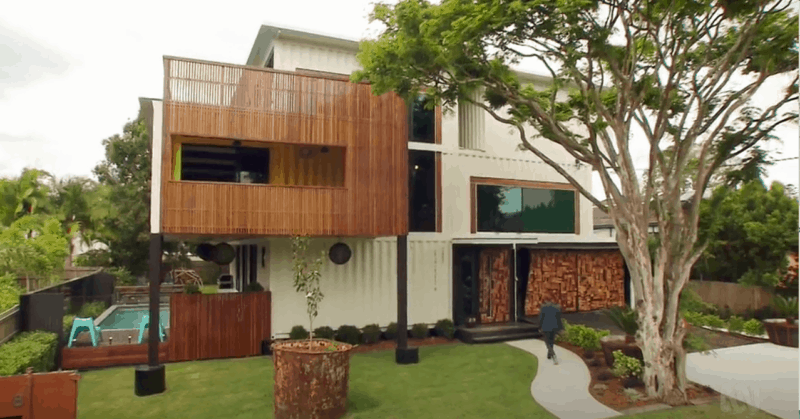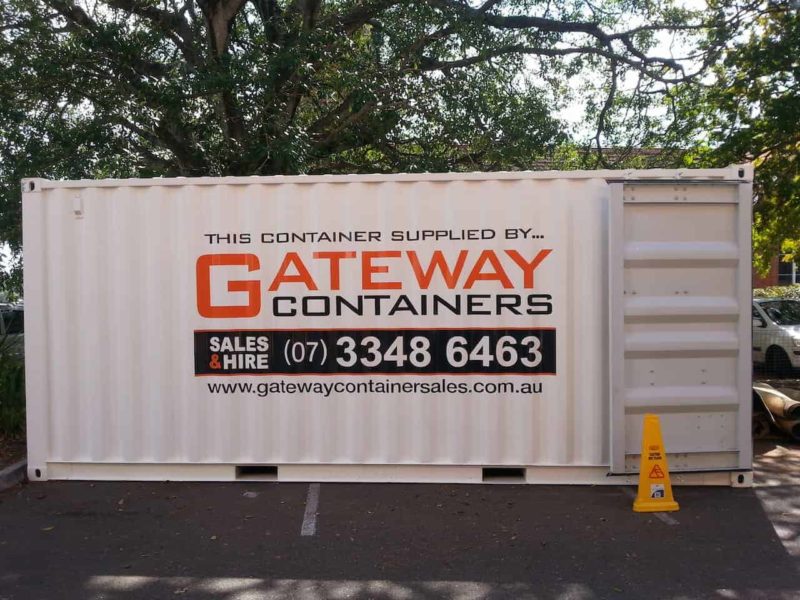In this article we look at everything to consider in hiring or buying a shipping container, so you can find out how to choose a shipping container that’s right for you.
As you will see in our previous blogs at the Gateway Gazette, the ways you can use shipping containers are only limited by your imagination! Whatever your intended purpose – transport, storage or architecture – there are some things to consider in choosing the right shipping container to hire or buy.
Why do you want a shipping container?
International Standard (ISO) containers were designed with one specific purpose in mind – getting goods from A to B by land and sea in a standardised way. This is still a common use, and there are hundreds of thousands of them used only once in a journey from China to Australia before sitting idle.
Many of those one-trip containers can be used reliably for transportation for many years to come. Used containers are a lot cheaper than new ones, even while their quality is hardly reduced from their first journey.
Storage is the second common use for containers. They are designed to weather the elements at sea without damage and can keep goods of all kinds in good condition for years at a time thanks to their hardwearing exteriors and high-quality seals.
The next use is almost limitless – containers can be adapted for architecture. Whether for small-scale shops or for huge hotels, containers form basic yet high quality building blocks that can be cut and welded together in almost any way imaginable.
One example of container architecture is a home built of containers supplied by Gateway Container Sales that was covered in Grand Designs Australia – just look at all the ways the owner and builder put them together!
What size of container do you need?

When it comes to hiring or buying a shipping container you first need to consider the size you need. Broadly these come in five sizes:
- Mini cube: 2.83 metres (10ft) long, 2.35m (7.7ft) wide and 2.36 metres (7.7ft) tall. Capacity 18 cubic metres.
- Small, general container: 5.89 metres (20ft) long, 2.35 metres (7.7ft) wide and 2.36 metres (7.7ft) tall. Capacity 33 cubic metres
- Small, high cube container: 5.89 metres (20ft) long, 2.35 metres (7.7ft) wide and 2.69 metres (8.8ft) tall. Capacity 37 cubic metres
- Large general container: 12.05 metres (40ft) long, 2.35 metres (7.7ft) wide and 2.36 metres (7.7ft) tall. Capacity 66 cubic metres
- Large high cube container: 12.05 metres (40ft) long, 2.35 metres (7.7ft) wide and 2.69 metres (8.8ft) tall. Capacity 76 cubic metres
As a general rule of thumb, a small, general shipping container will be able to store and transport the contents of a standard three bedroomed house. In most of them you could put a car in one, depending on its length!
Is temperature control an issue?
.jpg)
One of the best adaptations to shipping containers is the ‘reefer’ temperature controlled shipping container system. These have temperature control units on them and they are insulated so you can move perishable items almost anywhere in the world you want them to go.
Since they were invented by Maersk many years ago, reefer containers have come on leaps and bounds and you can now keep your goods at a tightly controlled temperature, as long as there is a three-phase electricity source to hand for the time that the goods are inside.
Gateway Containers can hire or sell these to you according to your needs. They are low-energy and come with a loading ramp, lighting, alarms and easy-open doors as standard.
What other modifications do you want?

Though the reefer container is of standard size and capacity there are almost limitless ways of adapting the basic shipping container form to suit your needs. You can choose a shipping container as a blank canvas for your requirements, with the basic sizes we looked at above as a starting point. Gateway Container Sales has a workshop on site that can help you make these modifications.
Let’s run through a list of modifications you could make to start you off:
- Remove the doors
- Add windows or doors to the ends or sides
- Remove the ends, sides, top or bottom
- Remove parts of the ends, sides, top or bottom
- Weld two together in any direction, though you can only stack up to eight high
- Insulate the insides
- Add utilities such as water, electricity or drainage
- Line the insides with stud walls and ceilings
- Fit a bathroom or kitchen
- Fit a bedroom or living area within
- Add shelving or racking
There could well be many others from the brief list above – as long as the concept fits within the standard dimensions and you have used reinforcements to maintain the structural rigidity, the list above could be almost limitless!
Storage containers

As we indicated above, the two most popular uses of containers are transport and as storage. Within the storage concept there are a couple of things to consider:
- Do you need to store your goods on-site? This might be as a shed at your home, or as a mobile workshop you can carry from site to site. In these cases it might make sense to buy one.
- Do you need a container that is off-site? You may have limited space at your home or work location yet may still need to store important things from family heirlooms to tax documents for a long time. Here at Gateway Container Sales we have an off-site storage option for as little as $15.40 a week for a small standard container.
Choosing to hire or buy a container

When to hire a shipping container:
- Do you need a reefer? These can be quite expensive to buy so it may pay to hire one even for a longer period.
- You may be moving goods across Australia and be able to return it to Gateway in Brisbane at a reasonable cost.
- How long do you need it for? If you need one for a short period as storage, perhaps after a fire or storm, then it may make sense to hire one.
- Do you need a new container for transporting or storing your goods due to the quality of the goods within? It may pay to hire one.
Reasons to buy a new or used shipping container:
- If you want the container for a piece of architecture and to be modified within or structurally you should buy one from us.
- In some cases for architectural use, it may pay to buy a new one to avoid issues like twisting or distorting that can occur in previous uses.
- As a cheap on-site permanent storage option a used one can be very cheap and will still last many years without degradation.
- International transport? It will generally be cheaper to buy one and to sell it on at your destination country.
Choosing the right shipping container broker
As with so many other lines of businesses, from private medical care to buying a used car, you need to be careful as to what shipping container broker you buy your shipping container from.
The first means of checking their quality and customer service is to check online reviews about them. TrustPilot is a review website that covers millions of companies around the world, and you can bet that someone will raise the alarm if they have been treated badly or sold a dud!
The next thing to check is the quality of the container itself, and whether there are other options should it not stand up to inspection. As with used car sales, some brokers have been known to weld two damaged containers together and paint them up to make them appear to be a good quality used one, and other tricks. If you smell a rat then it will generally pay to walk away and to go to another broker.
Choosing the right shipping container
.jpeg)
Not all containers have lived the same life!
They can be unevenly loaded and twist or bend, which is why for some architectural uses you should choose to buy a new shipping container.
Other containers have been badly abused or abandoned at times. Unscrupulous brokers have been known to weld two damaged shipping containers together. To avoid choosing a cut-and-shut or patched up container you should inspect it with your own eyes before committing to purchase or hire it. Consider the state of repair. Corten steel is designed to rust and for the rust to form a protective layer over the steel within. To some extent that’s perfectly fine. However, eventually the rust breaks through the steel and you get holes. Check rust patches to make sure that it is only on the surface.
You should look for any obvious signs that the shipping container has had repairs. Some have had minor repairs – is this good enough for your requirements? Bigger repairs – plates over holes for example – should have you walk away. What about the seals on the doors? These are meant to be weatherproof. Check the quality of the seals to make sure they aren’t rotten or overly worn.
Further questions to ask:
- How old is the container? If it is under five years old and in active transportation it will have had a CSC survey. Check the paperwork.
- Check the CSU plates on the doors to see when and where it was made.
- Does the container fit within the set dimensions of the ISO limits? If it isn’t this should raise the alarm and you should walk away. If it is out of the dimensions then you will have problems shipping it.
- The next thing is to look for is the ID plates. These will have the container’s serial number and are placed in a number of locations on it. You should check that these have not been removed from another (they will be tightly and securely in place) and the numbers on each ID plate should be identical.
So, there you have it!
Shipping containers may be simple boxes to look at but they aren’t just boxes! They can take a lot of abuse and modification without long term problems if treated right. That’s why, if you carefully choose the right shipping container for your needs, you will generally find that it serves you well for the purpose you hired or bought it.
So why wait? Give Gateway a call today to discuss your needs and our team will help you get what you need within your budget.




